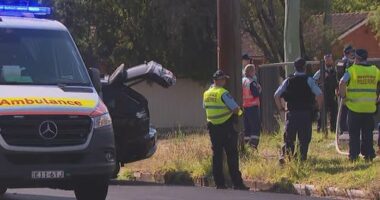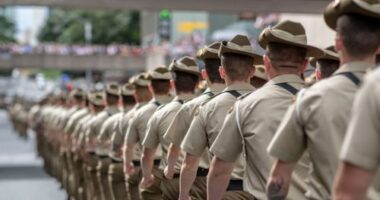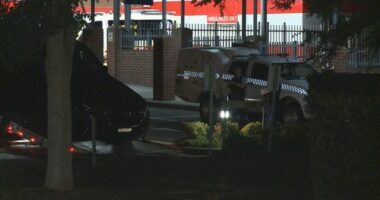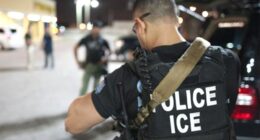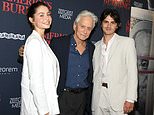Share this @internewscast.com
Tom Kopke, hailing from Munich, reigned supreme at Cooper’s Hill during the annual cheese rolling competition where participants raced down a dangerously steep 180m incline chasing after a rapidly rolling wheel of double Gloucester cheese.
Kopke was the first to reach the bottom of the hill behind the cheese.

“Everyone at the top claimed they would take my title, but this belongs to me,” a shirtless Kopke proclaimed as he held up his prize — the 3kg wheel of cheese.
“I risked my life for this. It’s my cheese. Back to back.”
The event, traditionally organized on the late-May public holiday near Gloucester, about 145km west of London, has been taking place for at least two centuries, possibly longer.
It’s attended by thousands, who pack the woods flanking the hill or take cover behind fences at the bottom, as competitors from around the world risk serious injury in the hope of glory.
Gravity and acceleration combine to leave few runners on their feet, leading to epic wipeouts that can result in twisted ankles, broken collarbones and concussions.

Ava Sender Logan, from London, won the women’s race after somersaulting and rolling at least a dozen times as she clutched her head.
“I will probably feel it tomorrow,” she said.
“It felt quite long coming down and then I hit my head. I’m down, that’s what matters. I’m fine.”
Dressed as Superman, Gloucester local Luke Briggs won the second men’s race, New Zealander Byron won the final men’s race and Ariel Denpsey won the women’s uphill race, but revealed she only took part for efficiency reasons.

Video footage of any cheese rolling race depicts a scene of utter chaos.
Few competitors are able to remain upright for very long, some are anxiously trying to maintain control by sliding on their bottoms, while others have lost all dignity, careening down in various states of distress.
Still images captured by photographers at the bottom present a confusing tableau, as if a giant has tipped a box of action figures out onto the hillside, bodies are upside down, or airborne sideways, and limbs are flailing everywhere.
“You’ve just got to have a disregard for your own safety,” Chris Anderson explained to CNN Sports.
Anderson won his first of his record 23 races in 2005 and broke his ankle in the celebrations, but the excruciating pain and eight weeks in a cast didn’t put him off.

The next year he won again, but he doesn’t remember much about his third victory in 2007, when he crossed the finish line unconscious.
“That was a bit of a blur,” he noted, recalling that he’d banged his head on the way down.
Anderson first attended the cheese rolling when he was around 10 years old, and he remembers seeing the mass of humanity flashing past him on the hill.
“It was so fun to watch people flying and falling,” he reminisced, adding that it wasn’t all fun and games.
“One of the most standout things was someone breaking their leg, his studs got stuck in the ground and the momentum just pushed him forward. He was sat in the middle of the hill with his leg just dangling, it was pretty disgusting!”

Serious injuries are practically guaranteed.
One year, Anderson witnessed three broken ankles, two of which belonged to international runners who missed their flights home because of emergency surgery.
Ankle injuries are common â some have witnessed feet out of alignment by 180 degrees â as are concussions; 2023 women’s champion Delaney Irving was knocked out just before the finish line and only learned of her triumph when she was told about it in the medical enclosure.
On the Netflix docuseries We Are the Champions, women’s record holder and four-time winner Flo Early revealed a protrusion of her right shoulder, a permanent disfigurement, caused by a collarbone that was broken on the hill.

It’s therefore no surprise that many runners might need a splash of alcohol in order to run.
Anderson said that the races used to start at 6.30pm in the evening, but the start time was moved earlier because too many people were intoxicated.
Now, runners in need of some Dutch courage just start drinking earlier.
Anderson told CNN Sports he prepares in moderation by drinking a single can of lager on the walk up.
“I always saw that if you were drunk and you broke something, there’s not a great deal they can give you for the pain, so I always try to do it as sober as possible,” he said.
Signs posted all over the hill make it clear that runners are participating at their own risk, the local enthusiasts who stage the event say they are not official organisers â in case of injury, there is nobody to sue, and the event is uninsured.

Anderson told CNN that he never had any intention of breaking the record of 21 cheese wins, which was set in 1991, but once he got to 13, he decided to keep going.
In 2011 and 2017, he won three races in a single day and he broke the record with two more wins in 2018.
At the age of 37, he’s recovering from a long-term hip injury â and he is “supposed to be retired” â but if his 16-year-old son decides to compete then he could be tempted back onto the hill, partly to make sure he does it right.
“I’d be happy for him to run,” he said, “but I’ve told him if you’re not gonna commit, there’s no point in even doing it.”
The veteran cheese-chaser knows that there are many ways to be hurt on the hill.
“The most dangerous thing is going slow and getting hit from behind. I’d like him to be quick enough to get away from the carnage.”
And if he ever decides to run again, he said it won’t be for the cheese: “I actually don’t like it. It’s got quite a strong aftertaste to it.”



